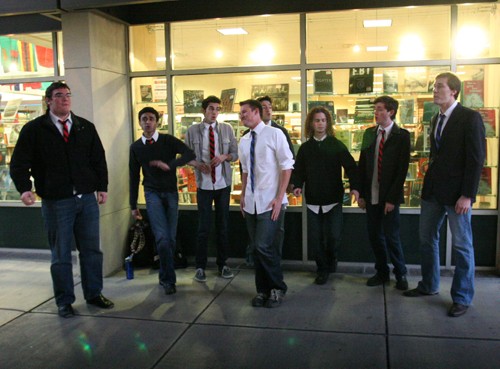The UA, like Tucson, is always ready to astonish you if you look in the right place at the right time. Last Monday, I had the great fortune of having my three-hour class cut one hour short, and was wandering around the Student Union Memorial Center when I stumbled upon such a place and time. Every Monday at 5 p.m., CatCall A Cappella, a group of nine men, gathers in front of the bookstore to sing a collection of songs for passers-by and then at 5:30 move to Sorority Row to serenade the lovely ladies of assorted sororities. And they are good.
History of glee
A glee club is a group of singers, traditionally male, that specializes in singing short songs, or glees, a term used to describe English songs popular between the 17th and 20th centuries.
The first so-called glee club was founded at the Harrow School in London in 1787. They were highly popular in the 19th century, but gradually met their demise at the hands of choral societies.
However, the name stuck in North American colleges and universities. Many East Coast schools have prominent glee clubs, most notably the Harvard Glee Club, founded in 1858, and the Yale Glee Club, founded in 1861, which have councils and auditions to select members.
Glee clubs are surprisingly popular in campus life today across the country, and not just on network television. They are the pride and joy of fraternities and choirs; CatCall A Cappella is the UA’s only such group.
Close-up on CatCall
Herbie Washington, a choral conducting major, founded CatCall A Cappella in 2008. There were seven original members, three of whom still remain in the group, who began learning and performing songs written and organized by Washington.
At the end of the year, they performed a concert in which 380 people attended and recorded an album, funded by ASUA. Now that Washington has graduated and CatCall has gone beyond its first year, they have expanded their group to nine people and have treated it like a business. They rehearse on a weekly basis and perform on campus on Mondays.
“”We prefer singing to gigs,”” said Sam Ellis, an original member and senior in accounting and entrepreneurship. “”We present in way that peers can relate to.””
CatCall A Cappella, along with two groups from ASU and a group from NAU, created the first Arizona A Cappella Fest and plan on having another festival in April 2011 in Tucson. This was is not only for members of an audience to take pleasure in, but also for the group themselves.
“”It’s performance-enhanced and educational,”” said vocal performance sophomore Ryan Phillips, a new member of the group.
Jack of all trades
Each member of CatCall brings something to the table. They work cohesively as a team and know how to have a good laugh; they are close friends.
There are four tenors and five basses. Two singers double as vocal percussionists.
Everyone gets a solo to showcase all the talent in the group. “”We love the fun of what we do,”” Ellis said.
CatCall’s repertoire includes contemporary songs such as “”Billionaire”” and “”Hey Soul Sister”” as well as time-honored songs like “”12 Days of Christmas,”” which is unexpectedly witty; several musical interludes towards the end of the piece are punctuated with mock confusion about which day of Christmas it actually is. Their renditions are highly original and the diversity of their pieces allow them to stand apart from the crowd while simultaneously pleasing it; the adept vocal percussion is functional and fashionable.
Check it out
The next time you’re in the student union on Monday night at 5 p.m., check these guys out. It’s everything you want to see in a performance. Keep your eyes peeled for red and blue ties and keep your ears tuned to the appealing sound of CatCall spreading a cappella to people who may or may not have ever heard it before.









